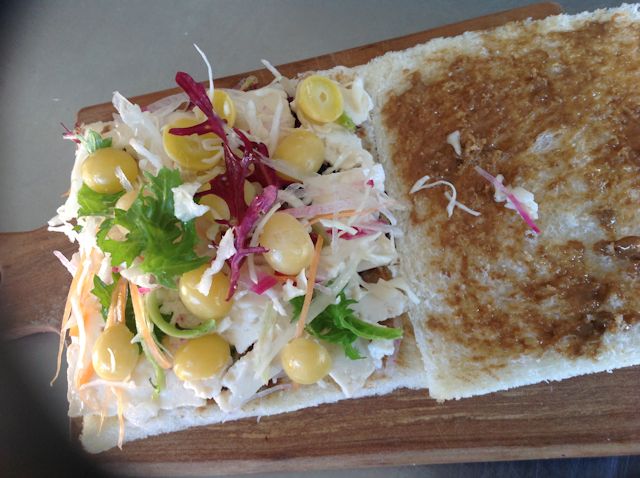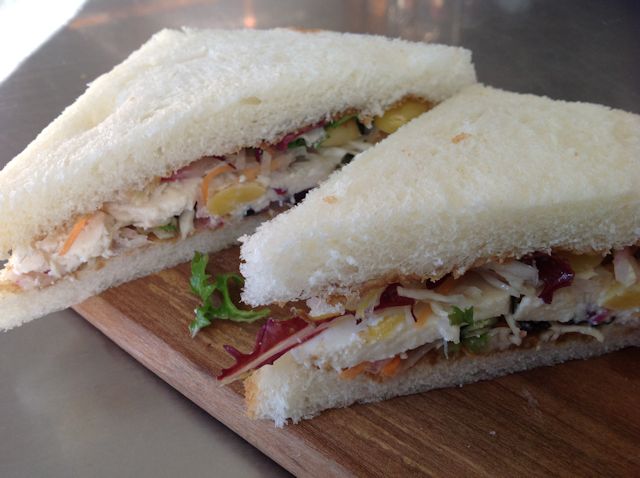Ginko nut and Hijiki mixed with sesame 銀杏とひじきの和え物 [Recipes, Fall 秋レシピ]
日本語のレシピは 最後の方に 載っています。
The summer has ended and sentimental season has arrived in Japan.
The leaves are turning to pale and some are already falling.
The trees appear to be lonley wearing less leaves.
On the contrary our appetite grow bigger during this season.
Luckily we can harvest lots of staples such as rice, nuts and fruits, which can satisfy our stomachs and hearts.
.jpg)
The rice is ready to be harvested.
The perssimmons' color is getting orangier and orangier day by day.
The persimmon leaf is so colorful and beautiful.
I picked up the chestnus which were still sitting comfortably in their husk..jpg)
The Cosmos are at their best now and blooming everywhere in my town.
Isn't it wonderful ?
The nature always blesses us with her profound love if we follow the rule of the universe.
All right, now I am going to pass you one of my nut recipes.
Which nut do you think I am going to show you today ?
It has double layered shells, and is protected tightly inside.
If you walk towards the tree, you'll notice its exsistance from quite far away as it smells so strong.
Its leaves are green until early autumn, but change to beautiful yellow color by late autumn.
The shape of the leaf is very unique and looks like a Japanese fan.
The nut tastes a little bitter.
If you are a Japanese food lover, I am sure that you have seen it in Chawanmushi.
I guess by now you know the answer.
It is ...
Can you tell what they are ?
Here's a closer look. They are fallen off the tree and sitting still on the ground here.
Yes, they are ginko nuts.
Do you know that there are female ginko nut trees and male ginko nut trees ?
And only the female trees can bear the nuts.
It is easy to pick them up, but you have to be careful, as the first layer of the shell that we have to touch when we pick them up can irritate our skin quite badly and you might have rashes on your hands. So I advise you to wear gloves.
The ginko nuts have to be soaked in the water overnight.
The next day, peel off the first layer shell with the gloves on.
This layer is supposed to be very soft. (and also very smelly)
After removing the first layer, dry them under the sun for a few days.
The inner shell is hard unlike the first layer.
When you eat, crack the hard outer shell with the pench or the hammer, and cook in the boiled water, roast in the skillet or fry with the oil, in a way you want.
I have a special instrument to crack the ginko nust shell.
This is very useful when you have lots of nuts to crack.
Well, I am now passing you a very healthy ginko nut recipe.
Here you go !
The ginko nuts and Hijiki sea vegetable mixed with sesame
Ingredients (for 2 servings)
5 strings green beans
20 ginko nuts - shelled, refer to the note for preparation
10g dried hijiki sea vegetables
1 tsp salt
2 Tbsp white sesame seeds
2 tsp mirin or 1 tsp sweeter ( maple syrup, rice syrup)
1 tsp soy sauce
Procedure
- Wash and soak hijiki in water for 15 minutes.
- Roast and grind the white sesame seeds.
- Mix sesame seeds, mirin and soy sauce in a bowl.
- Fill the pot with water, bring to a boil, add salt and green beans, cook till soft (about one to a few minitues) and take out. Cut into 1 inch length.
- Using the same boiling water, cook ginko nuts till soft (about 5 minutes), skin the brown layer using the bottom part of the spoon or with your fingers.
- Using the same boiling water, cook hijiki for a few minutes and drain.
- Mix above three ingredients with the sesame paste of "procedure 1".
Tips and information
- It is advisable to remove the tiny embryo (?) after cracking the shell and removing the soft skin. Some people say that the ginko nuts can be poisonous and better not give more than a few pieces to children.
I like ginko nuts and sometimes eat lots at one time, but never experieced the food poisoning nor uncomforableness though I am very sensitive to some foods which are too stimulous such as coffeine and alcohole. I feel removing this part could minimize this risk.
- There are two types of hijiki seaweed basically, baby hijiki which is thin and short, and old hijiki which is thicker and longer.
The old one is considered more Yang compared with baby one, and when we say hijiki in Macrobiotics, it means old one. For this recipe, you can use either of them.
The one in the photo is the old one.
Here are the sandwiches that I made with ginko nuts.

Spread the sesame paste and miso mixure on the bread, and then place the seasonal vegetables of your choice, Tofu cheese and boiled ginko nuts, pour olive oil, salt and pepper. Sandwich with another piece of bread and slice into two pieces.
Here's another ginko nut sandwich.
Spread the tofu mayonaise which was mixed with pungent mustard over the bread, place the thinly sliced cuccumers, which was massaged with salt and then excess water squeezed out, and mixed with grinded flax seeds.
hmm...they are so yummy. I love these sandwiches !!
I'm sure you can't resist them too !!
The ginko nut leaves will be very yellow in a few weeks time like this.
This is a small shrine in my neighbourhood.
銀杏とひじきの胡麻和え
材料 (2人分)
さやいんげん 5本 殻を取り除いた銀杏 20粒 乾燥ひじき 10g
塩 小さじ1
白胡麻 大さじ2 みりん 小さじ2 しょうゆ 小さじ1
作り方
- ひじきを 15分くらい 水につけて もどす。
- 白胡麻を煎って 擂る。
- ボールに 煎った胡麻、みりん、しょうゆを入れて 混ぜあわせておく。
- 鍋に水を入れて 沸騰させ、さやいんげんと塩を入れて、お好みのかたさに茹でる。 取り出して2㎝位の長さに切っておく。(お湯はこの後も使うので、そのままの状態にしておく。)
- 同じ鍋に 銀杏を入れて 柔らかくなるまで 茹でる。 取り出して スプーンの背で押すか、指で 茶色の薄皮を とりのぞく。
- 同じ鍋で ひじきを 茹でる。
- さやいんげん、銀杏、ひじきを 3の胡麻ペーストで 和える。
銀杏を使う場合の 下処理に関して
日本では 銀杏は食べすぎると 食中毒を起こすと 言われています。
私は 銀杏が好きなので たくさん食べてしまうこともあるのですが 中毒症状を起こしたことはありません。
ただ、普段から下処理を怠った食べ物や 刺激が強い食べ物には すぐ反応してしまうので 銀杏をたくさん食べたいときには ちゃんと 以下のような下処理をしています。
銀杏を殻から取り出し 薄皮をむきます。 その後で 爪楊枝をお尻の方からやさしく刺し通して 幼芽の部分を 取り除きます。
ポイント
- 銀杏は、ペンチ、キッチンバサミのギザギザの所で 割ります。 銀杏割り器があると、簡単に割れます。
- ひじきは、長ひじきでも 芽ひじきでも お好きな方を お使いください。
- こういったシンプルな和食は、具材の質も去ることながら、調味料が 大事です。 昔ながらの製法で作られた しょうゆやみりんを使うと おいしさがアップします。 そして、それは、体にも、環境にも 影響しますから、できるだけ、そんな調味料を使ってみて下さいね。
Happy Cooking !
_00001.jpg)
_00001.jpg)
_00001.jpg)






コメント 0